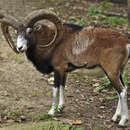Biology
provided by Arkive
Mouflon tend to feed early in the morning and in the evening, resting during the day under an overhanging bush or rock, where they are well hidden. Mouflon are gregarious and form non-territorial herds grazing on grasses, unless food is scarce when they will turn to browsing leaves and fruits. The senses are well developed as the sheep are dependent on early detection of, and flight from, approaching predators, particularly leopard, wolf and jackal. Mouflon have an average life span of between eight and ten years for males and ten to twelve years for females and reach sexual maturity at about two to three years, although in populations with low hunting pressure, males are unlikely to reproduce before four years of age (4). Females usually give birth to a single lamb (occasionally twins) after a gestation period of five to six months (6).
Conservation
provided by Arkive
Few conservation measures for the mouflon have been documented and the successes of those which have been are unknown. Three of the mouflon subspecies are listed on Appendix I of the Convention on International Trade in Endangered Species (CITES), forbidding international trade. However, national trade is still allowed and poaching remains a problem. The Punjab government, in Pakistan, has declared 12 protected areas within the range of the mouflon, and there is one game reserve which is managed by the community, but enforcement is poor and there is still no restriction on domestic livestock (1). Outright protection of certain areas may seem like the best option, but in many areas this is not feasible due to human settlements and pasture. It is thought that without enforced protection efforts, numbers of this wild sheep will continue to decline and subspecies will be lost (7).
Description
provided by Arkive
The males of this exceedingly wary wild sheep have large sickle-shaped horns, which are prized by many a trophy hunter. For most subspecies, females also have horns, but they are much smaller than the horns of the males. In a few populations, most or all females do not grow horns (4). The different subspecies vary slightly in overall appearance; colour also varies with season and between males and females. The face is generally greyish with a white muzzle, nostrils and inside of the ears. The legs are long and slender with a vertical black line below the knees (5) (6). Mouflon have a white belly and a coat that varies in colour from grey with a reddish tinge to brown and coffee coloured, while male European mouflon (O. o. musimon) are dark chestnut and females are beige (5). The adult rams tend to develop a substantial chest ruff of long, coarse hair, which tends to be white in the throat region, turning to black as it extends down to the forelegs (6). In most of the mouflon subspecies the males also have a lighter coloured saddle patch, which develops and increases in size as they get older and a black stripe, which begins midway along the nape of the neck and along the shoulders before continuing under the body, ending behind the back legs (5). Mouflon have large glands beneath the eye, which often exudes a sticky substance that mats the hair (6).
Habitat
provided by Arkive
Generally found in mountainous areas with both grasslands and desert, although in Europe mouflon have also been introduced into forested areas (1). Mouflon occur up to 3,000 metres above sea level and prefer the gentler slopes of the higher mountain ranges with a reasonable amount of cover, and use steep precipitous regions to avoid predators (4).
Range
provided by Arkive
Mouflon are found throughout various countries in central Asia, from Turkey in the west, to Pakistan in the east (1).Subspecies are found throughout the area but some are more restricted in range than others, for example, O. o. isphahanica (Esfahan mouflon) and O. o. laristanica (Laristan mouflon) are restricted to Iran and O. o. vignei (Ladahk urial) occurs in India and Pakistan (1).
Populations are also found in a number of Mediterranean countries which are thought to be the result of introduction by people during the last few centuries, originating from Corsica or Sardinia. It is believed they are descendents of feral sheep and have been widely introduced as an exotic to many countries (4).
Status
provided by Arkive
Classified as Vulnerable (VU) on the IUCN Red List 2007 (1) and a number of subspecies are listed on CITES (3). The taxonomy of the mouflon is very complex and there is no general consensus on how many separate species and subspecies there are. Many scientists recognise two separate species: the Urial (Ovis vignei) and the Mouflon (Ovis gmelini) together with a number of subspecies (4). However, at present the IUCN Red List recognises the mouflon as one species (1). The unresolved taxonomy is a problem for conservation as specimens are often hard to identify, and hybrids exist naturally (4).
Threats
provided by Arkive
The mouflon is threatened by the expansion of agriculture and farming, resulting in a reduction in population numbers and dispersal into small, fragmented groups. The expansion of sheep farming throughout their range has resulted in overgrazing and erosion, reducing the amount of suitable habitat for the mouflon. O. o. cycloceros (Afghan mouflon) avoids mountainous terrain and therefore competes directly with livestock. Consequently hunting pressure is high, resulting in a fragmented distribution. Contagious diseases and parasites from domestic livestock, particularly domestic sheep, are a major threat in many areas (4). Adult rams are poached for the trophy value of their horns and lambs are sometimes taken at birth to be kept as pets (1).

